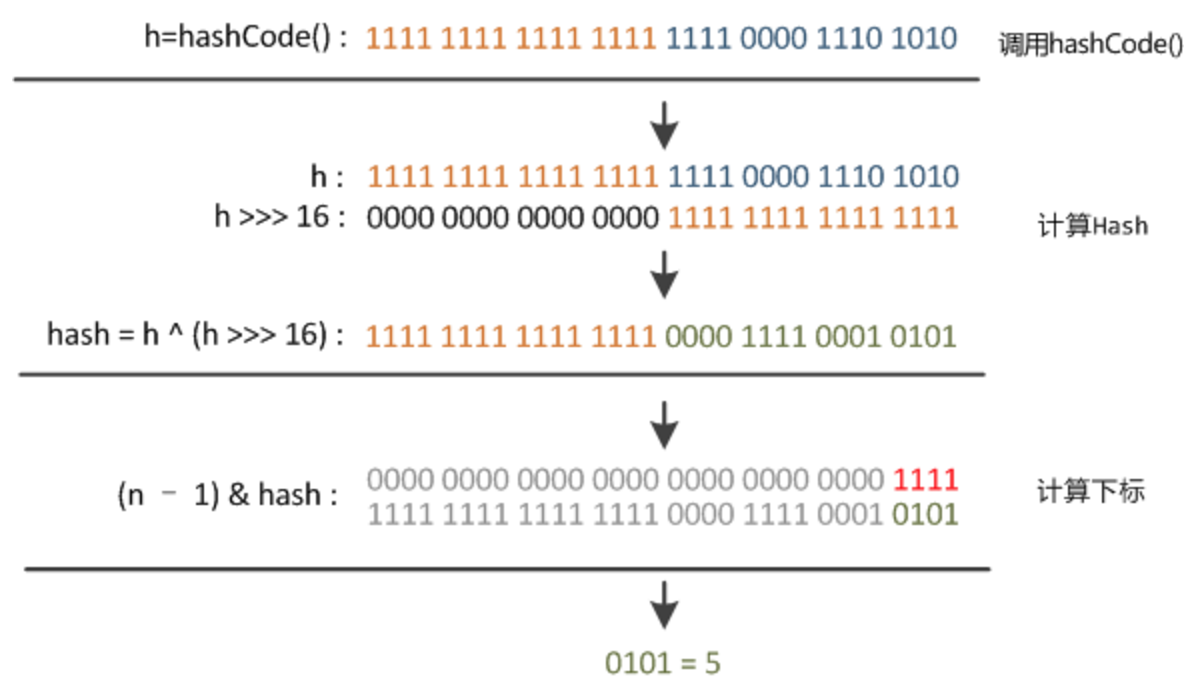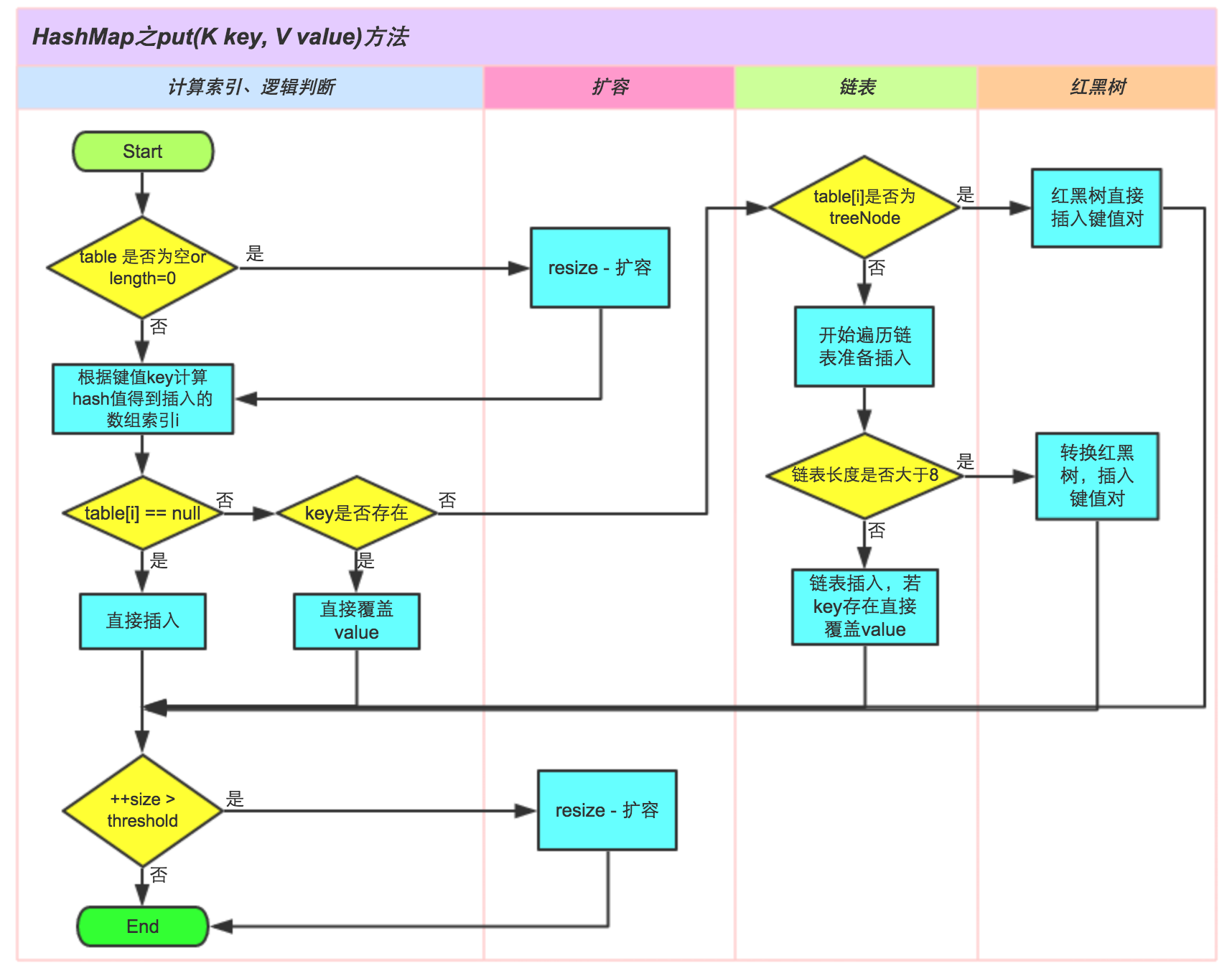本文 java version “1.8.0_221”
属性字段
static final int DEFAULT_INITIAL_CAPACITY = 1 << 4; // 初始默认容量大小,如果指定容量,容量必须是 2 的倍数
static final int MAXIMUM_CAPACITY = 1 << 30; // 最大的容量大小 1*2^30=1073741824 ,如果指定容量,容量必须是 2 的倍数
static final float DEFAULT_LOAD_FACTOR = 0.75f; // 默认负载因子
static final int TREEIFY_THRESHOLD = 8; // 超过 8 就变为 红黑树
static final int UNTREEIFY_THRESHOLD = 6; // 小于 6 变为链表
transient Node<K,V>[] table; // 存放元素的哈希桶数组
transient int size; // 当前 Map 中 键值对数量
final float loadFactor; // 负载因子
int threshold; // 当前 Map 能容纳的最大键值对数量,threshold = length * Load factor
transient int modCount; // 结构性修改的次数,用于 fail-fast 机制
key 对应到哈希桶的过程
1
2
3
4
5
6
| static final int hash(Object key) {
int h;
return (key == null) ? 0 : (h = key.hashCode()) ^ (h >>> 16);
}
index = hash(key) & (length - 1)
|
若 key == null,放到数组第一位
key != null,调用 Object.hashCode() 方法将 key 进行 hash 得到 h
将 h 与 h 右移 16 位后的数值进行异或得到一个 hash 值
将第 3 步得到 hash 值与数组长度减一进行与运算,得到 key 在哈希桶的索引位置。
第 4 步非常巧妙,它通过 h&(table.length -1)来得到该对象的保存位,而 HashMap 底层数组的长度总是2的n次方,这是 HashMap 在速度上的优化。当 length 总是 2 的 n 次方时,h& (length-1)运算等价于对 length 取模,也就是h%length,但是 & 比 % 具有更高的效率。

get 方法
1
2
3
4
5
6
7
8
9
10
11
12
13
14
15
16
17
18
19
20
21
22
23
24
25
26
27
28
| public V get(Object key) {
Node<K,V> e;
return (e = getNode(hash(key), key)) == null ? null : e.value;
}
final Node<K,V> getNode(int hash, Object key) {
Node<K,V>[] tab; Node<K,V> first, e; int n; K k;
if ((tab = table) != null && (n = tab.length) > 0 && (first = tab[(n - 1) & hash]) != null) { // 找到 hash 值一样的桶
if (first.hash == hash && // always check first node
((k = first.key) == key || (key != null && key.equals(k)))) // 如果第一个元素 key 相同,返回这个 Node
return first;
if ((e = first.next) != null) {
if (first instanceof TreeNode)
return ((TreeNode<K,V>)first).getTreeNode(hash, key); // 如果是树节点,那么去树里面找
do {
if (e.hash == hash &&
((k = e.key) == key || (key != null && key.equals(k)))) // 在链表中找
return e;
} while ((e = e.next) != null);
}
}
return null;
}
static final int hash(Object key) {
int h;
return (key == null) ? 0 : (h = key.hashCode()) ^ (h >>> 16);
}
|
put 方法

table 为 null 或者 tab.size = 0,进行 resize。
key 进行 hash 之后取模得到的索引位置,若在桶的位置元素为 null,那么直接插入元素。
桶位置元素不为 null,那么进行比较
判断 key 是否相同:
- 如果 key 相同,e 保存该节点
- 如果 key 不同,如果该是红黑树节点,那么执行红黑树的 put 方法;如果是链表节点,执行链表遍历操作,找到对应的节点并用 e 保存,如果链表长度大于 >=7,就将链表转为红黑树
Node e 保存找到的节点,如果没有找到返回 null
如果 size 超过阈值,进行扩容
1
2
3
4
5
6
7
8
9
10
11
12
13
14
15
16
17
18
19
20
21
22
23
24
25
26
27
28
29
30
31
32
33
34
35
36
37
38
39
40
41
42
43
44
45
46
47
48
49
50
51
52
53
54
55
56
57
| public V put(K key, V value) {
return putVal(hash(key), key, value, false, true);
}
final V putVal(int hash, K key, V value, boolean onlyIfAbsent,
boolean evict) {
Node<K,V>[] tab; Node<K,V> p; int n, i;
if ((tab = table) == null || (n = tab.length) == 0)
n = (tab = resize()).length;
// 如果 table 的在(n-1)&hash 的值是 null,就新建一个节点插入在该位置
if ((p = tab[i = (n - 1) & hash]) == null)
tab[i] = newNode(hash, key, value, null);
// 表示该索引位置有值
else {
Node<K,V> e; K k;
// 如果 key 相等,那么 Node e 保存原来的值用于替换
if (p.hash == hash && ((k = p.key) == key || (key != null && key.equals(k)))){
e = p;
// 如果 key 最终不等,而且是树节点,执行红黑树的 put 方法
} else if (p instanceof TreeNode)
e = ((TreeNode<K,V>)p).putTreeVal(this, tab, hash, key, value);
// 如果 key 最终不等,而且是链表节点,执行链表的 put 方法
else {
for (int binCount = 0; ; ++binCount) {
// 如果指针为空就挂在后面
if ((e = p.next) == null) {
p.next = newNode(hash, key, value, null);
if (binCount >= TREEIFY_THRESHOLD - 1) // -1 for 1st
// 链表数量 >= 7 就转为红黑树
treeifyBin(tab, hash);
break;
}
// 链表上面有相同的 key 的元素,那么 e 保存原来的值
if (e.hash == hash &&
((k = e.key) == key || (key != null && key.equals(k))))
break;
p = e;
}
}
// 最终 Map 中有该元素,那么进行 value 替换
if (e != null) { // existing mapping for key
V oldValue = e.value;
if (!onlyIfAbsent || oldValue == null)
e.value = value;
afterNodeAccess(e);
return oldValue;
}
}
// 结构修改次数加 1
++modCount;
// 如果新增一个元素后容量大于阈值,进行扩容
if (++size > threshold)
resize();
afterNodeInsertion(evict);
return null;
}
|
resize 方法
- 扩容是 2 倍的倍数进行扩容
- 扩容后,换一个更大的数组重新映射,元素的位置要么是在原位置,要么是在原位置再移动 2 次幂的位置。
1
2
3
4
5
6
7
8
9
10
11
12
13
14
15
16
17
18
19
20
21
22
23
24
25
26
27
28
29
30
31
32
33
34
35
36
37
38
39
40
41
42
43
44
45
46
47
48
49
50
51
52
53
54
55
56
57
58
59
60
61
62
63
64
65
66
67
68
69
70
71
72
73
74
75
76
77
78
| final Node<K,V>[] resize() {
Node<K,V>[] oldTab = table;
int oldCap = (oldTab == null) ? 0 : oldTab.length;
int oldThr = threshold;
int newCap, newThr = 0;
if (oldCap > 0) {
// 如果原来的桶长度已经超过最大阈值,那么数组扩大到 2^31 -1
if (oldCap >= MAXIMUM_CAPACITY) {
threshold = Integer.MAX_VALUE;
return oldTab;
// 如果原来桶长度扩大 2 倍后还是小于最大阈值,那么新阈值为原来阈值的 2 倍
} else if ((newCap = oldCap << 1) < MAXIMUM_CAPACITY && oldCap >= DEFAULT_INITIAL_CAPACITY){
newThr = oldThr << 1; // double threshold
}
} else if (oldThr > 0){ // initial capacity was placed in threshold
newCap = oldThr;//
} else { // zero initial threshold signifies using defaults
newCap = DEFAULT_INITIAL_CAPACITY;
newThr = (int)(DEFAULT_LOAD_FACTOR * DEFAULT_INITIAL_CAPACITY);
}
if (newThr == 0) {
float ft = (float)newCap * loadFactor;
newThr = (newCap < MAXIMUM_CAPACITY && ft < (float)MAXIMUM_CAPACITY ?
(int)ft : Integer.MAX_VALUE);
}
threshold = newThr;
@SuppressWarnings({"rawtypes","unchecked"})
Node<K,V>[] newTab = (Node<K,V>[])new Node[newCap];
table = newTab;
if (oldTab != null) {
for (int j = 0; j < oldCap; ++j) {
Node<K,V> e;
if ((e = oldTab[j]) != null) {
oldTab[j] = null;
if (e.next == null)
newTab[e.hash & (newCap - 1)] = e;
else if (e instanceof TreeNode)
((TreeNode<K,V>)e).split(this, newTab, j, oldCap);
else { // preserve order
// 链表优化重hash的代码块
Node<K,V> loHead = null, loTail = null;
Node<K,V> hiHead = null, hiTail = null;
Node<K,V> next;
do {
next = e.next;
// 原索引
if ((e.hash & oldCap) == 0) {
if (loTail == null)
loHead = e;
else
loTail.next = e;
loTail = e;
}
// 原索引+oldCap
else {
if (hiTail == null)
hiHead = e;
else
hiTail.next = e;
hiTail = e;
}
} while ((e = next) != null);
// 原索引放到bucket里
if (loTail != null) {
loTail.next = null;
newTab[j] = loHead;
}
// 原索引+oldCap放到bucket里
if (hiTail != null) {
hiTail.next = null;
newTab[j + oldCap] = hiHead;
}
}
}
}
}
return newTab;
}
|
博客参考
HashMap的底层实现
Java8的HashMap详解(存储结构,功能实现,扩容优化,线程安全,遍历方法),是下面的总结
Java 8系列之重新认识HashMap

